Shamba (agroforestry system)

Shamba (Swahili for 'plantation'; pl. Mashamba) is an agroforestry system practiced in East Africa, particularly Kenya. In these lands various crops are combined: bananas, beans, yams and corn, to which are added timber resources, beekeeping, medicinal herbs, mushrooms, forest fruits, fodder for livestock, etc.[1] Thanks to this polyculture, farmers obtain a higher share of income, food and employment.[2] Furthermore, it is more sustainable and generates a smaller ecological footprint than monocultures.
The system was created in Kenya in the mid-19th century to extend land cultivation and meet the demand for firewood.[3] A 2009 study estimated that in Kenya, where the state owns these plantations, there are some 160,000 hectares of shambas.[2] However, the management of the shambas has been tainted by corruption, which Kenyan farmers' associations have denounced on many occasions.[1] Large wooded areas were allowed to be converted to farmland. Moreover, the introduction of non-native species such as eucalyptus or cypress has been a problem. Wangari Maathai called for "not sacrificing native forests at the expense of exotic plantations".[3]
Text is available under the CC BY-SA 4.0 license; additional terms may apply.
Images, videos and audio are available under their respective licenses.
